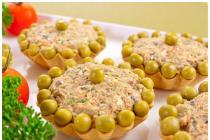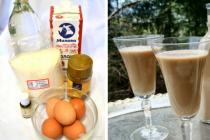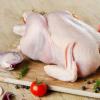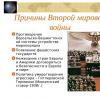Chapter:
William Vasilievich Pokhlebkin
"NATIONAL COOKES OF OUR PEOPLES"
7th page of the section
Russian kitchen
SECOND COURSES - MEAT DISHES
In Russian folk cuisine, three main types of meat main courses can be distinguished:
Boiled meat in large pieces, cooked in soups and porridges, and then used as a main course or as a cold appetizer;
Dishes from offal (liver, omentum, rennet), baked together with cereals in pots;
Dishes from a whole animal (bird) or from a part of it (legs), or from a large piece of meat (rump, rump), fried in an oven on a baking sheet, the so-called roast.
Various cutlets, meatballs, meatballs, quenelles, prepared from ground meat, borrowed and widespread only in the 19th-20th centuries, are not typical for classical Russian cuisine and therefore are not given here.
In the past, as side dishes for meat dishes on the Russian table, porridge and gruel were usually used, in which the meat was boiled, then either boiled, or rather steamed and baked, root vegetables (turnips, carrots), as well as mushrooms; with the roast, regardless of the meat used, in addition, pickles were also served - sauerkraut, pickled and sour apples, soaked lingonberries, infusions.
In modern conditions, baked vegetables for Russian meat dishes are conveniently prepared in aluminum food foil. The role of gravy is usually played by the juice formed during frying, as well as melted sour cream and melted butter, which are used to pour over boiled vegetables or flavor porridges, i.e., a side dish. Sauces for meat dishes, i.e. gravies made with flour, butter, eggs and milk, are not typical of native Russian cuisine.
DISHES FROM BOILED MEAT
Ingredients:
1 head (veal or pork), 4 legs (veal or pork), 1 carrot, 1 parsley (root), 10 black peppercorns, 5 Jamaican (allspice) peppercorns, 5 bay leaves, 1-2 onions, 1 head of garlic , for 1 kg of meat - 1 liter of water.
Preparation
Scorch the legs and head, clean, cut into equal pieces, add water and cook for 6 to 8 hours over very low heat, without boiling, so that the volume of water is reduced by half. 1-1.5 hours before the end of cooking, add onions, carrots, parsley, 20 minutes - pepper, bay leaf; add a little salt.
Then remove the meat, separate from the bones, cut into small pieces, place in a separate bowl, mix with finely chopped garlic and a small amount of ground black pepper.
Boil the broth with the remaining bones for another half hour to an hour (so that its volume does not exceed 1 liter), add salt, strain and pour it over the boiled prepared meat.
Let cool for 3-4 hours.
Gelatin is not used, since young meat (veal, pig, pork) contains a sufficient amount of sticky substances.
Serve the jelly with horseradish, mustard, crushed garlic and sour cream.
COOKED BEEF
Boiled beef in large pieces (1.5-2 kg) is boiled in gruels (Tikhvin, Kostroma) and less often in bone broths (bone broth is prepared in advance and then the meat is immersed in boiling broth).
For boiled beef, mainly the shoulder and thigh parts are used, as well as the edge, the thin edge.
The usual cooking time is 2.5 hours over moderate heat.
DISHES FROM OFF-PRODUCTS (BAKED)
Ingredients:
1 lamb head, 4 lamb legs, 1 lamb rennet, 2 cups buckwheat, 4 onions, 100 g butter or sunflower oil.
Preparation
1. Boil the lamb head and legs so that the meat itself comes off the bones. Separate the meat. Take the brain out of your head.
2. Cook cool buckwheat porridge.
3. Finely chop the lamb meat along with the onion, mix with porridge and butter.
4. Thoroughly scrape out the lamb rennet, wash it, stuff it with the prepared minced meat (step 3), put the brains in the middle, sew up the rennet and place it in a clay dish (in a korchagu - a wide clay pot), which is tightly closed.
Place in a low-heat oven for 2-3 hours.
STUFFING BOX
Ingredients:
1 lamb caul, 1 kg of lamb liver, 1.5-2 cups of buckwheat, 3 eggs, 3 onions, 5-6 dry porcini mushrooms, 1 cup of sour cream.
Preparation
Soak the liver for 2 hours in water or milk, boil, chop finely, mix with buckwheat porridge cooked with onions and crushed dry mushrooms and knead with sour cream into a thick mass.
Fill the stuffing box with it, which was previously placed in a pot (a wide clay pot) so that the edges of the stuffing box tightly overlap this mass on top.
Close the pot.
Bake the oil seal in the oven for 1-1.5 hours over moderate heat.
PEREPECHA
Ingredients:
1.5 kg of lamb liver, 1 lamb caul, 4 eggs, 1-1.5 glasses of milk, 1 head of garlic, 2 onions, 10 black peppercorns.
Preparation
1. Wash the raw liver, peel off the films, boil with boiling water, finely chop, and then grind with finely chopped onion, garlic and pepper.
2. Beat two full eggs and two yolks and mix with milk.
3. Combine the products indicated in points 1 and 2, pour into a lamb cauldron placed in a clay pot, cover with the edges of the caulk on top, brush with beaten egg whites and bake in the oven or oven for 2-3 hours over low heat.
FRILLED MEAT DISHES
ROASTED PIG
Ingredients:
1 suckling pig (1.5 kg), 500 g buckwheat, 50 g butter, 2 tbsp. spoons of sunflower or olive oil.
Preparation
Preparing the pig.
Wash a well-fed pig with cold water, keep it in it for 3-4 minutes, then put it in boiling water for 2-3 minutes, carefully pluck out the bristles without damaging the skin, rub with flour, singe, then cut open, gut, wash inside and outside, after which it is desirable cut out all the bones (ribs, spine) from the inside, with the exception of the head and legs, under no circumstances cutting through the meat and skin.
Preparation of minced meat.
Prepare cool buckwheat porridge, but do not flavor it with anything other than butter. Before cooking, fry the cereal with butter, scald with boiling water, and separate the floating grains. Season the finished porridge with moderate salt. Add fried and chopped pig liver to it, stir.
Stuffed pig.
Place the porridge evenly along the pig along its entire length, so as not to distort its shape, avoid thickening in certain places, and at the same time be quite tight. Then sew the piglet up with a harsh thread, straighten the shape, bend the legs, place it on a baking sheet sideways on birch sticks placed crosswise so that the skin of the pig does not touch the baking sheet. You cannot add salt or flavor with spices.
Roasting a pig.
Coat the pig with vegetable oil, pour melted butter on top and place in a preheated oven until browned. Then turn over and brown the other side. After this, reduce the heat and continue to fry, pouring the draining juice over the pig every 10 minutes for 1 hour and turning it over alternately: fry for 15-20 minutes with its back facing up.
When the pig is ready, make a deep cut along its back so that steam comes out of the pig and it does not sweat. This will keep the crust dry and crispy. Let stand for 15 minutes, cut into pieces (or leave whole), pour over the remaining juice after frying and serve with cranberry infusion.
ROAST
Ingredients:
2-2.5 kg of well-fed beef (thick edge), 1 carrot, 2 onions, 1 parsley or celery, 6-8 grains of black pepper, 3-4 bay leaves, 2 teaspoons of ginger, 0.5 cups sour cream, 1 teaspoon of salt, 1-1.5 cups of kvass.
Preparation
Wash the beef, remove films and bones, cut off the fat, cut it into small pieces, put it on a preheated frying pan or baking sheet, melt it, heat it, fry the beef in it in a whole piece until crusty, sprinkling with finely chopped carrots, onions, parsley and crushed spices, then place in the oven, pour a little kvass every 10 minutes, turning all the time.
Fry for about 1-1.5 hours.
5-7 minutes before the end of frying, collect all the juice in a cup, add 0.25 cups of cold boiled water to it, and put it in the refrigerator.
When the juice has cooled, remove the layer of fat from the surface, heat the meat juice, strain, add sour cream. Serve as a sauce for roasts.
Remove the finished beef from the oven, add salt, let it cool slightly (15 minutes), then cut across the grain into pieces, pour over hot meat juice and serve.
Roasts are not served cold or heated.
The side dish can be fried potatoes, boiled or stewed carrots, turnips, rutabaga, fried or stewed mushrooms.
EXPLOSIONS TO ROAST
The infusions have a plant base - vegetable or berry. Additional ingredients often include vinegar and honey.
The most traditional infusions are onion, cabbage, and cranberry.
ONION BOIL
Ingredients:
5-6 onions, 2-3 tbsp. spoons of vinegar, 1-2 tbsp. spoons of honey, 1 tbsp. a spoonful of ghee (or 2 tablespoons of vegetable oil), 0.5-1 teaspoon of ground pepper.
Preparation
Chop the onion, moisten with vinegar, let stand for 5-10 minutes, then lightly fry in a frying pan until soft, sweeten with honey, simmer until the liquid thickens over low heat, pepper and salt.
Serve with roast lamb, goose, and turkey.
CABBAGE BOLD
Ingredients:
1 half-liter jar of sauerkraut, 2 onions, 50 g melted butter, 2 tbsp. spoons of vinegar, 2 tbsp. spoons of honey, 1 teaspoon of ground black pepper.
Preparation
Chop the cabbage as finely as possible, fry in oil in a frying pan along with finely chopped onion until soft, mix well with vinegar, boiled with honey (in a separate enamel bowl - mug, saucepan), grind everything thoroughly, simmer again a little, season with pepper. , salt.
Serve with goose, boiled and fried beef.
CRANBERRY BLAST
Ingredients:
1 half-liter jar of cranberries, 75-100 g honey, 1 tbsp. a spoonful of flour (preferably rye or the cheapest wheat).
Preparation
Squeeze juice from cranberries. Pour the marc with 1 cup of boiling water, boil well in a saucepan, squeeze again, cool and dissolve the flour in this cranberry water.
Boil the juice with honey until slightly thickened, add cranberry water and flour at the moment of boiling and boil again.
Serve with roasted pig and turkey.
07.09.2016
Soup for headaches and cloudy mood. Don't believe me? There is one. An original recipe from a very worthy person, proven by experience. William Vasilievich Pokhlebkin. A true representative of the Russian intelligentsia.
Listen to his interviews, they can still be found on the Internet. The atmosphere of pre-perestroika kitchens will immediately come to life, where a glass of hot tea and a conversation until the morning was ready for everyone, because before it was impossible to tear yourself away. There, without looking back, in an emotional frenzy, brilliant thoughts were given away left and right. It was then that they began to calculate how much each such word was worth.
There were those who turned them into quite impressive fees. But this did not add happiness to them. The original Russian mind, tested by the tradition of conscience, is difficult to spoil with education or infect with self-interest. Just as grass breaks through asphalt, so it will make itself felt through the most callous sediment of an alien culture. Pokhlebkin, a Russian thinker, is so Russian that you are amazed, as if he came out of fairy tales.
At the age of 17, he volunteered for the front. Served in intelligence. I went through almost the entire war. Due to a serious injury, he could no longer serve. While still at the front, he mastered German and three other languages perfectly. In 1949 he graduated from MGIMO University of the USSR Ministry of Foreign Affairs. His foreign-sounding name, however, does not have foreign roots at all. In fact, his name is Vil, which means Vladimir Ilyich Lenin. Full name - Wil-August.
His father, the Russian underground revolutionary Mikhailov, named his son in honor of Vladimir Lenin and August Bebel. However, “Pitchfork” was re-voiced as “William,” perhaps influenced by profession. Pokhlebkin is one of the best experts on foreign policy in Central and Northern Europe. He defended his dissertation on the latest diplomacy of Norway. Worked at the Institute of History of the USSR Academy of Sciences.
He taught at MGIMO, the Higher Diplomatic School of the USSR Ministry of Foreign Affairs, and at Moscow State University. The President of Finland, Kekkonen, awarded William Vasilyevich a prize for the best work about Finland. Pokhlebkin gave this prize, $50,000, to the Soviet government. He himself preferred poverty. In everyday life - an ascetic, in thought - an ascetic, in honor - a flint. Devoted to the Fatherland when others nearby lose their way. Kind and, in Russian, deep and trusting.
Cooking has been his hobby since childhood. And this is a great gift to us, because a man who speaks 6 languages, is experienced in diplomatic etiquette, and has a subtle aristocratic taste, which is unattainable without a nobility of soul, took up cooking.
Recipe V.V. Pokhlebkina No. 1
The promised soup. In order for even a very severe headache to disappear, with a 100% guarantee, you need to boil one and a half liters of water, add 20 white peppercorns and a teaspoon of salt (without top). If sellers tell you that such pepper does not exist, do not believe them. Peppercorns should be cooked for 20 minutes. Only then will the soup work. Next, you need carp and mushrooms. While the pepper is cooking, the carp must be cleaned, rinsed and placed in cold water acidified with lemon. Let it stand for now.
Carefully place 2-3 porcini mushrooms into boiling water. Before doing this, finely chop them if they are fresh. Crush into powder if dry. All you need is porcini mushrooms! It is strictly forbidden to replace them with others. The Russian taste will go away, and the soup will not work, the headache will not go away. Dip one or two potatoes, 1 carrot, 1 turnip, 2 onions and two tomatoes into the soup. Cut them first too.
After 10 minutes, add the fish cut into four pieces into the soup, and then add the spices: celery, dill, parsley and bay leaf. After 15 minutes, turn off the heat and cover the pot with a lid. Note that before this the soup was cooked without a lid! Let it sit for 2-3 minutes and you are ready to serve. There is no need to wait for a headache, especially a severe one, to try the soup.
Recipe V.V. Pokhlebkina No. 2
Especially relevant in winter. Medicinal milk, which can be used as a medicine for diseases of the ear, nose and throat, is a tasty medicine. Pour a liter of milk into a saucepan, add half a glass of cool water, half a teaspoon of star anise, a pinch of mint and 3-4 crushed black peppercorns. Place the saucepan in the oven. Be guided by your oven. But, usually, half an hour is enough for the milk to become melted. Try not to let it boil. After 20 minutes, turn down the heat and simmer for another 5-7 minutes. If you cook for pleasure and not because of illness, you can drink it with sugar. It's great to mix it with strong tea.
Recipe V.V. Pokhlebkina No. 3
If you are feeling low or feel numb, cook some fried fruit. You need to take dry fruits and fry them only in butter or ghee. Therefore, they need to be eaten hot. You can add a little water to the fried fruits and cover the frying pan with a lid and keep it on the fire until the water evaporates. The fruits will steam and become similar in shape to fresh ones, but not in taste. This dish will help if one of your loved ones is recovering from a serious illness. Well, and if it’s sad.
If you want something like this, feel free to experiment. After reading the books by V.V. Pokhlebkina, you will simply be irresistibly drawn to experiments. And experimentation is incompatible with depression. And Pokhlebkin’s books too.
Russian cuisine has long been widely known throughout the world. This is manifested in the direct penetration into international restaurant cuisine of native Russian food products (caviar, red fish, sour cream, buckwheat, rye flour, etc.) or some of the most famous dishes of the Russian national menu (jelly, cabbage soup, fish soup, pancakes, pies, etc.), and in the indirect influence of Russian culinary art on the cuisines of other peoples.
Assortment of Russian cuisine at the turn of the 19th and 20th centuries. became so diverse, and its influence and popularity in Europe were so great that by this time they started talking about it with the same respect as the famous French cuisine.
Russian national cuisine has gone through an extremely long development path, marked by several major stages, each of which left an indelible mark.
Old Russian cuisine, which developed from the 9th-10th centuries. and which reached its greatest flourishing in the 15th-16th centuries, although its formation covers a huge historical period, it is characterized by general features that have largely been preserved to this day.
At the beginning of this period, Russian bread from sour (yeast) rye dough appeared - this uncrowned king on our table, without it even now the Russian menu is unthinkable - and also all the other most important types of Russian bread and flour products arose: the familiar saiki, bagels, sochni, pyshki, pancakes, pancakes, pies, etc. These products were prepared exclusively on the basis of sour dough - so characteristic of Russian cuisine throughout its historical development. The predilection for sour and kvass was also reflected in the creation of Russian real jelly - oatmeal, wheat and rye, which appeared long before modern ones. Mostly berry jelly.
Various gruels and porridges, which were originally considered ritual, ceremonial food, also occupied a large place on the menu.
All this bread and flour food was varied most often with fish, mushrooms, wild berries, vegetables, milk and very rarely meat.
The appearance of classic Russian drinks - all kinds of honey, kvass, sbitney - dates back to the same time.
Already in the early period of the development of Russian cuisine, a sharp division of the Russian table into lean (vegetable-fish-mushroom) and fast (milk-egg-meat) was evident, which had a huge impact on its further development until the end of the 19th century. The artificial creation of a line between the fast and fast table, the isolation of some products from others, and the prevention of their mixing ultimately led to the creation of only some original dishes, and the entire menu as a whole suffered - it became more monotonous and simplified.
We can say that the Lenten table was luckier: since most days of the year - from 192 to 216 in different years - were considered fast (and these fasts were observed very strictly), there was a natural desire to expand the range of the Lenten table. Hence the abundance of mushroom and fish dishes in Russian cuisine, the tendency to use various plant materials - grain (porridge), vegetables, wild berries and herbs (nettle, snot, quinoa, etc.).
Moreover, they have been so famous since the 10th century. vegetables such as cabbage, turnips, radishes, peas, cucumbers were prepared and eaten - whether raw, salted, steamed, boiled or baked - separately from one another. Therefore, for example, salads and especially vinaigrettes have never been characteristic of Russian cuisine and appeared in Russia already in the 19th century. as a borrowing from the West. But they were also originally made mainly with one vegetable, giving the corresponding name to the salad - cucumber salad, beet salad, potato salad, etc.
Each type of mushroom - milk mushrooms, mushrooms, honey mushrooms, white mushrooms, morels, pecheritsa (champignons), etc. - was salted or cooked completely separately, which, by the way, is still practiced today. The same can be said about fish, which was consumed boiled, dried, salted, baked and, less often, fried. In the literature we come across juicy, “tasty” names for fish dishes: sigovina, taimenina, pike, halibut, catfish, salmon, sturgeon, stellate sturgeon, beluga and others. And the fish soup could be perch, ruff, burbot, sterlet, etc.
Thus, the number of dishes by name was huge, but all of them differed little from each other in content. Flavor diversity was achieved, firstly, by the difference in heat and cold processing, as well as by the use of various oils, mainly vegetable (hemp, nut, poppy, olive and, much later, sunflower), and secondly, by the use of spices. Of the latter, onions, garlic, horseradish, dill were most often used, and in very large quantities, as well as parsley, anise, coriander, bay leaves, black pepper and cloves, which appeared in Rus' already in the 10th-11th centuries. Later, in the 15th - early 16th centuries, they were supplemented with ginger, cardamom, cinnamon, calamus (fir root) and saffron.
In the initial period of the development of Russian cuisine, there also developed a tendency to consume liquid hot dishes, which then received the general name “khlebova”. The most widespread types of bread are such as cabbage soup, stews based on vegetable raw materials, as well as various mash, brews, chatterboxes, salomat and other types of flour soups.
As for meat and milk, these products were consumed relatively rarely, and their processing was not difficult. Meat, as a rule, was cooked in cabbage soup or gruel, and milk was drunk raw, stewed or sour. Cottage cheese and sour cream were made from dairy products, and the production of cream and butter remained almost unknown for a long time, at least until the 15th-16th centuries. These products appeared rarely and irregularly.
The next stage in the development of Russian cuisine is the period from the middle of the 16th century. and until the end of the 17th century. At this time, not only further development of variants of the Lenten and Fast table continues, but also the differences between the cuisines of different classes and estates are especially sharply outlined.
From this time on, the cuisine of the common people began to become more and more simplified, the cuisine of the boyars, nobility and especially the nobility became more and more refined. It collects, combines and generalizes the experience of previous centuries in the field of Russian cooking, creates on its basis new, more complex versions of old dishes, and also for the first time borrows and openly introduces into Russian cuisine a number of foreign dishes and culinary techniques, mainly of Eastern origin.
Particular attention is paid to the fast festive table of that time. Along with the already familiar corned beef and boiled meat, spun (i.e., cooked on spits) and fried meat, poultry and game occupy a place of honor on the table of the nobility. Types of meat processing are becoming increasingly differentiated. Thus, beef is used mainly for preparing corned beef and for boiling (boiled slaughter); Pork is used to make ham for long-term storage, or it is used as fresh meat or suckling pig in fried and stewed form, and in Russia only meat, lean pork is valued; finally, lamb, poultry and game are used mainly for roasting and only partly (lamb) for stewing.
In the 17th century All the main types of Russian soups finally took shape, while kalia, pokhmelki, solyanka, and rassolniki, unknown in medieval Rus', appeared.
The Lenten table of the nobility is also enriched. A prominent place on it begins to be occupied by balyk, black caviar, which was eaten not only salted, but also boiled in vinegar or milk of poppy seeds.
On the cookery of the 17th century. Oriental and primarily Tatar cuisine has a strong influence, which is associated with the accession in the second half of the 16th century. to the Russian state of the Astrakhan and Kazan khanates, Bashkiria and Siberia. It was during this period that dishes made from unleavened dough (noodles, dumplings), products such as raisins, apricots, figs (figs), as well as lemons and tea, the use of which has since become traditional in Russia, came into Russian cuisine. Thus, the sweet table is significantly replenished.
Next to gingerbread, known in Rus' even before the adoption of Christianity, one could see a variety of gingerbreads, sweet pies, candies, candied fruits, numerous jams, not only from berries, but also from some vegetables (carrots with honey and ginger, radish in molasses) . In the second half of the 17th century. Cane sugar (1) began to be brought to Russia, from which, together with spices, they made candies and snacks, sweets, delicacies, fruits, etc. But all these sweet dishes were mainly the privilege of the nobility (2).
- (1) The first refinery was founded by the merchant Vestov in Moscow at the beginning of the 18th century. He was allowed to import cane raw materials duty-free. Sugar factories based on beet raw materials were created only at the end of the 18th - beginning of the 19th centuries. (The first plant is in the village of Alyabyevo, Tula province).
(2) The menu of the patriarchal dinner for 1671 already indicated sugar and candy.
At the same time, there is a desire to decorate dishes. Palaces and fantastic animals of gigantic proportions are built from food products. Court dinners turn into a pompous, magnificent ritual, lasting 6-8 hours in a row - from two o'clock in the afternoon to ten in the evening - and include almost a dozen courses, each of which consists of a whole series (sometimes two dozen) of dishes of the same name, for example from a dozen varieties of fried game or salted fish, from a dozen types of pancakes or pies (3).
- (3) The order of serving dishes at a rich festive table, consisting of 6-8 changes, finally took shape in the second half of the 18th century. However, they began to serve one dish at each break. This order remained until the 60-70s of the 19th century:
1) hot (cabbage soup, soup, fish soup);
2) cold (okroshka, botvinya, jelly, jellied fish, corned beef);
3) roast (meat, poultry);
4) vegetable (boiled or fried hot fish);
5) pies (unsweetened), kulebyaka;
6) porridge (sometimes served with cabbage soup);
7) cake (sweet pies, pies);
8) snacks.
All kinds of casseroles and puddings turned out to be alien to ancient Russian cuisine. The desire to prepare a dish from a whole large piece, and ideally from a whole animal or plant, persisted until the 18th century. The exception, it seemed, was the fillings in pies, in whole animals and poultry, and in their parts - rennet, caul. However, in most cases these were, so to speak, ready-made fillings, crushed by nature itself - grain (porridge), berries, mushrooms (they were not cut either). The fish for the filling was only flattened, but not crushed. And only much later - at the end of the 18th century. and especially in the 19th century. - already under the influence of Western European cuisine, some fillings began to be specially crushed.
The next stage in the development of Russian cuisine begins at the turn of the 17th and 18th centuries. and lasts a little more than a century - until the first decade of the 19th century. At this time, there was a radical demarcation between the cuisine of the ruling classes and the cuisine of the common people. If in the 17th century. The cuisine of the ruling classes still retained a national character and its difference from folk cuisine was expressed only in the fact that in terms of quality, abundance and range of products and dishes it was sharply superior to folk cuisine, then in the 18th century. The cuisine of the ruling classes gradually began to lose its Russian national character.
Since the times of Peter the Great, the Russian nobility and the rest of the nobility have borrowed and introduced Western European culinary traditions. Rich nobles visiting Western Europe brought foreign chefs with them. At first these were mostly Dutch and German, especially Saxon and Austrian, then Swedish and mainly French. From the middle of the 18th century. foreign cooks were hired so regularly that they soon almost completely replaced the cooks and serf cooks of the upper nobility.
One of the new customs that appeared at this time is the use of snacks as an independent dish. German sandwiches, French and Dutch cheeses that came from the West and were hitherto unknown on the Russian table were combined with ancient Russian dishes - cold corned beef, jelly, ham, boiled pork, as well as caviar, balyk and other salted red fish in a single serving or even in a special meal - breakfast.
New alcoholic drinks also appeared - ratafia and erofeichi. Since the 70s of the 18th century, when tea began to become increasingly important, in the highest circles of society, sweet pies, pies and sweets were separated from lunch, which were combined with tea in a separate serving and dedicated to 5 o’clock in the evening.
Only in the first half of the 19th century, after the Patriotic War of 1812, in connection with the general rise of patriotism in the country and the struggle of Slavophile circles against foreign influence, advanced representatives of the nobility began to revive interest in national Russian cuisine. However, when in 1816 the Tula landowner V.A. Levshin tried to compile the first Russian cookbook, he was forced to admit that “information about Russian dishes has almost completely disappeared” and therefore “it is now impossible to provide a complete description of the Russian cookery and should be content with only by what can still be collected from what remains in memory, for the history of the Russian cookery has never been given over to description” (4). As a result, the descriptions of Russian cuisine dishes collected by V. A. Levshin from memory were not only not accurate in their recipes, but also in their assortment they did not reflect all the actual richness of the dishes of the Russian national table.
- (4) Levshin V.A. Russian cookery. M., 1816.
During this period, a number of French chefs worked in Russia, radically reforming the Russian cuisine of the ruling classes. The first French chef to leave a mark on the reform of Russian cuisine was Marie-Antoine Carême - one of the first and few research chefs and chef-scientists. Before arriving in Russia at the invitation of Prince P.I. Bagration, Karem was the cook of the English Prince Regent (future King George IV), Duke of Württemberg, Rothschild, Talleyrand. He was keenly interested in the cuisines of various nations. During his short stay in Russia, Karem became familiar with Russian cuisine in detail, appreciated its merits and outlined ways to free it from superficiality.
Karem's successors in Russia continued the reform he began. This reform affected, firstly, the order of serving dishes to the table. Adopted in the 18th century. The “French” serving system, when all dishes were put on the table at the same time, was replaced by the old Russian method of serving, when one dish replaced another. At the same time, the number of changes was reduced to 4-5 and a sequence was introduced in serving lunch, in which heavy dishes alternated with light ones that stimulated the appetite. In addition, meat or poultry cooked whole was no longer served on the table; they began to be cut into portions before serving. With such a system, decorating dishes as an end in itself has lost all meaning.
The reformers also advocated replacing dishes made from crushed and pureed products, which occupied a large place in the cuisine of the ruling classes in the 18th - early 19th centuries, with dishes made from natural products more typical of Russian cuisine. This is how all kinds of chops (lamb and pork) from a whole piece of meat with a bone, natural steaks, clops, splints, entrecotes, escalopes appeared.
At the same time, the efforts of culinary specialists were aimed at eliminating the heaviness and indigestibility of some dishes. So, in cabbage soup recipes, they discarded the flour flavor that made them tasteless, which was preserved only by tradition, and not by common sense, and began to widely use potatoes as side dishes, which appeared in Russia in the 70s of the 18th century.
For Russian pies, they suggested using soft puff pastry made from wheat flour instead of sour rye. They also introduced a straight method of preparing dough using pressed yeast, which we use today, thanks to which sour dough, which previously required 10-12 hours to prepare, began to ripen in 2 hours.
French chefs also paid attention to snacks, which became one of the specific features of the Russian table. If in the 18th century. The German form of serving snacks predominated - sandwiches, then in the 19th century. they began to serve appetizers on a special table, each type on a special dish, decorating them beautifully, and thus expanded their range so much, choosing among the appetizers a whole range of ancient Russian not only meat and fish, but also mushroom and pickled vegetable dishes, that their abundance and diversity henceforth never ceased to be a constant object of wonder to foreigners.
Finally, the French school introduced the combination of products (vinaigrettes, salads, side dishes) and precise dosages in dish recipes, which had not previously been accepted in Russian cuisine, and introduced Russian cuisine to unknown types of Western European kitchen equipment.
At the end of the 19th century. The Russian stove and pots and cast iron specially adapted to its thermal conditions were replaced by a stove with its oven, saucepans, stewpans, etc. Instead of a sieve and sieve, colanders, skimmers, meat grinders, etc. began to be used.
An important contribution of French culinary specialists to the development of Russian cuisine was that they trained a whole galaxy of brilliant Russian chefs. Their students were Mikhail and Gerasim Stepanov, G. Dobrovolsky, V. Bestuzhev, I. Radetsky, P. Grigoriev, I. Antonov, Z. Eremeev, N. Khodeev, P. Vikentiev and others, who supported and spread the best traditions of Russian cuisine to throughout the entire 19th century. Of these, G. Stepanov and I. Radetsky were not only outstanding practitioners, but also left behind extensive manuals on Russian cooking.
In parallel with this process of updating the cuisine of the ruling classes, carried out, so to speak, “from above” and concentrated in the noble clubs and restaurants of St. Petersburg and Moscow, there was another process - the collection, restoration and development of forgotten ancient Russian recipes, which spontaneously took place in the provinces, in the landowners estates until the 70s of the XIX century. The source for this collection was folk cuisine, in the development of which a huge number of nameless and unknown, but talented serf cooks took part.
By the last third of the 19th century. Russian cuisine of the ruling classes, thanks to its unique assortment of dishes and their exquisite and delicate taste, began to occupy, along with French cuisine, one of the leading places in Europe.
At the same time, it is necessary to emphasize that, despite all the changes, introductions and foreign influences, its main characteristic features have been preserved and remain inherent to it to this day, since they have been firmly retained in folk cuisine. These main features of Russian cuisine and the Russian national table can be defined as follows: the abundance of dishes, the variety of the snack table, the love of eating bread, pancakes, pies, cereals, the originality of the first liquid cold and hot dishes, the variety of fish and mushroom table, the widespread use of pickles from vegetables and mushrooms, an abundance of festive and sweet table with its jams, cookies, gingerbreads, Easter cakes, etc.
Some features of Russian cuisine should be said in more detail. Back at the end of the 18th century. Russian historian I. Boltin noted the characteristic features of the Russian table, including not only the wealthy. In rural areas, there were four meal times, and in the summer during working hours - five: breakfast, or snack, afternoon tea, before lunch, or exactly at noon, lunch, dinner and supper.
These vyti, adopted in Central and Northern Russia, were also preserved in Southern Russia, but with different names. There, at 6-7 a.m. they ate, at 11-12 they had lunch, at 14-15 they had an afternoon snack, at 18-19 they had an evening meal, and at 22-23 they had dinner. With the development of capitalism, working people in cities began to eat first three, and then only two times a day: they had breakfast at dawn, lunch or dinner when they came home. At work, they only ate midday, that is, they ate cold food. Gradually, lunch began to be called any full meal, a full table with hot brew, sometimes regardless of the time of day.
Bread played a big role at the Russian table. For cabbage soup or another first liquid dish in the village, they usually ate from half a kilo to a kilogram of black rye bread. White bread, made from wheat, was actually not common in Russia until the beginning of the 20th century. It was eaten occasionally and mainly by the wealthy segments of the population in cities, and among the people they looked at it as a holiday food. Therefore, white bread, called bun (5) in some regions of the country, was baked not in bakeries, like black bread, but in special bakeries and was slightly sweetened. Local varieties of white bread were Moscow saiki and kalachi, Smolensk pretzels, Valdai bagels, etc. Black bread differed not by place of production, but only by the type of baking and type of flour - pecked, custard, hearth, peeled, etc.
- (5) “Bun” - from the French word boule, which means “round like a ball.” Initially, white bread was baked only by French and German bakers.
The first liquid dishes, called from the end of the 18th century, retained constant importance in Russian cuisine. soups. Soups have always played a dominant role on the Russian table. No wonder the spoon was the main cutlery. It appeared in our country before the fork by almost 400 years. “A fork makes the same fish, and a spoon makes the same thing as a net,” said the popular proverb.
The assortment of national Russian soups - cabbage soup, zatirukh, pottage, fish soup, pickles, solyanka, botvinya, okroshka, prison - continued to expand in the 18th-20th centuries. various types of Western European soups such as broths, puree soups, various filling soups with meat and cereals, which took root well thanks to the love of the Russian people for hot liquid brew.
In the same way, many soups of the peoples of our country have found a place on the modern Russian table, for example, Ukrainian borscht and kulesh, Belarusian beetroot soups and soups with dumplings. Many soups, especially vegetable and vegetable-cereal soups, were obtained from liquefied gruels (i.e., gruels with vegetable filling) or represent the fruits of restaurant cuisine. However, it is not they, despite their diversity, but old, native Russian soups like cabbage soup and fish soup that still determine the uniqueness of the Russian table.
To a lesser extent than soups, fish dishes have retained their original meaning on the Russian table. Some classic Russian fish dishes like telny have fallen out of use. Meanwhile, they are tasty and easy to prepare. They can be prepared from sea fish, which, by the way, was used in Russian cuisine in ancient times, especially in Northern Russia, in Russian Pomerania. Residents of these grainless areas in those days have long been accustomed to cod, halibut, haddock, capelin, and navaga. “Lack of fish is worse than lack of bread,” was the saying of the Pomors at that time.
Known in Russian cuisine are steamed, boiled, whole fish, i.e. made in a special way from one fillet, boneless, fried, mended (filled with porridge or mushroom filling), stewed, jellied, baked in scales, baked in a frying pan in sour cream , salted (salted), dried and dried (suschik). In the Pechora and Perm regions, fish was also fermented (sour fish), and in Western Siberia they ate stroganina - frozen raw fish. The only uncommon method was the method of smoking fish, which developed mainly only over the last 70-80 years, i.e., from the beginning of the 20th century.
Characteristic of ancient Russian cuisine was the widespread use of spices in a fairly large assortment. However, the reduction in the role of fish, mushroom and game dishes, as well as the introduction of a number of German cuisine dishes into the menu, affected the reduction in the share of spices used in Russian cuisine.
In addition, many spices, due to their high cost, as well as vinegar and salt, have been used since the 17th century. People began to use re in the process of cooking, and put it on the table and use it during meals, depending on everyone’s desire. This custom gave rise to later claims that Russian cuisine supposedly did not use spices. At the same time, they referred to the famous work of G. Kotoshikhin about Russia in the 17th century, where he wrote: “There is a custom of cooking without seasonings, without pepper and ginger, lightly salted and without vinegar.” Meanwhile, the same G. Kotoshikhin further explained: “And when the nets begin and in which there is little vinegar and salt and pepper, they add it to the food on the table” (6).
- (6) Kotoshikhin G. About Russia during the reign of Alexei Mikhailovich. St. Petersburg 1840.
Finally, in conclusion, it is necessary to dwell on some technological processes characteristic of Russian cuisine.
For a long period of development of Russian national cuisine, the process of cooking was reduced to boiling or baking products in a Russian oven, and these operations were necessarily carried out separately. What was intended for cooking was boiled from beginning to end, what was intended for baking was only baked. Thus, Russian folk cuisine did not know what combined or even different, combined or double heat treatment was.
Thermal processing of food consisted of heating the Russian oven with heat, strong or weak, in three degrees - “before the bread”, “after the bread”, “in a free spirit” - but always without contact with the fire and either with a constant temperature kept at the same level, or with falling, decreasing temperatures as the oven gradually cooled, but never with increasing temperatures, as with stovetop cooking. That’s why the dishes always turned out not even boiled, but rather stewed or half-steamed, half-stewed, which is why they acquired a very special taste. It is not without reason that many dishes of ancient Russian cuisine do not make the proper impression when they are prepared in different temperature conditions.
Does this mean that it is necessary to restore the Russian stove in order to obtain real Russian cuisine in modern conditions? Not at all. Instead, it is enough to simulate the thermal regime of falling temperature it creates. Such imitation is possible under modern conditions.
However, we should not forget that the Russian stove had not only a positive, but to a certain extent also a negative impact on Russian cuisine - it did not stimulate the development of rational technological techniques.
The introduction of stove-top cooking led to the need to borrow a number of new technological techniques and, along with them, dishes from Western European cuisine, as well as to the reform of dishes of ancient Russian cuisine, their refining and development, and adaptation to new technology. This direction turned out to be fruitful. It helped save many Russian dishes from oblivion.
Speaking about Russian cuisine, we have so far emphasized its features and characteristic features, considered the history of its development and its content as a whole. Meanwhile, one should keep in mind the pronounced regional differences in it, explained mainly by the diversity of natural zones and the associated dissimilarity of plant and animal products, the different influences of neighboring peoples, as well as the diversity of the social structure of the population in the past.
That is why the cuisines of Muscovites and Pomors, Don Cossacks and Siberians are very different. While in the North they eat venison, fresh and salted sea fish, rye pies, money with cottage cheese and a lot of mushrooms, on the Don they fry and stew steppe game, eat a lot of fruits and vegetables, drink grape wine and make pies with chicken. If the food of the Pomors is similar to Scandinavian, Finnish, Karelian and Lapp (Sami), then the cuisine of the Don Cossacks was noticeably influenced by Turkish and Nogai cuisine, and the Russian population in the Urals or Siberia follows Tatar and Udmurt culinary traditions.
Regional features of a different kind have long been inherent in the cuisines of the old Russian regions of Central Russia. These features are due to the medieval rivalry between Novgorod and Pskov, Tver and Moscow, Vladimir and Yaroslavl, Kaluga and Smolensk, Ryazan and Nizhny Novgorod. Moreover, they manifested themselves in the field of cuisine not in major differences, such as differences in cooking technology or the presence of their own dishes in each region, as was the case, for example, in Siberia and the Urals, but in differences precisely between the same dishes, in differences are often even insignificant, but nevertheless quite persistent.
A striking example of this is such common Russian dishes as fish soup, pancakes, pies, porridge and gingerbread: they were made throughout European Russia, but each region had its own favorite types of these dishes, its own minor differences in their recipe, its own appearance , your serving techniques, etc.
We owe this, so to speak, “small regionality” to the emergence, development and existence so far, for example, of different types of gingerbread - Tula, Vyazma, Voronezh, Gorodetsky, Moscow, etc.
Regional differences, both large and small, naturally further enriched Russian cuisine and diversified it. And at the same time, all of them did not change its basic character, because in each specific case, the general features noted above attract attention, which together distinguish national Russian cuisine throughout Russia from the Baltic to the Pacific Ocean.
Maybe there is a book by Pokhlebkin in your library? About tea, vodka, porridge, pancakes, entertaining cooking? Then this is not surprising: the circulation of his books approaches one hundred million, and he is published and republished all over the world. “A funny pseudonym,” you probably thought, “William Pokhlebkin is somehow exquisitely culinary.” The way it is. When a highly educated person has a hobby, he becomes a professional at it. This was the case when doctor V.V. Dahl compiled the “Living Dictionary of the Russian Language”, doctor A.P. Chekhov became a classic of Russian literature. And Candidate of Historical Sciences V.V. Pokhlebkin became a historian of Russian cuisine.
Pokhlebkin William Vasilievich
His full name is William August. Born into the family of the revolutionary leader Mikhailov, the child received a revolutionary name: Wil-August. It is composed of the initials of the leader and the name of Bebel, a German revolutionary.
Pokhlebkin William Vasilyevich is from the generation that in 1941, immediately after the graduation party, went to the front. He was a scout and went through the entire war. He knew Serbo-Croatian, German, Italian and Swedish. In his last year he served as an orderly in a soldier’s kitchen, where his talents began to be discovered.
After the war, he graduated from MGIMO and worked at the Institute of History of the Academy of Sciences. Not finding common ground with his superiors, he quits and conducts research privately. His royalties from translations support the Scandinavian Collection magazine.
For a long time he lived on 38 kopecks a day, eating only tea and black bread. His recipes were published in the Ogonyok magazine. The culinary column in the Nedelya newspaper was so valued that people bought the newspaper only because of it. “Science and Life” published two of his books in parts on its pages.
He was married twice, but family life did not work out. The children, daughter Gudrun and son August, now live abroad.
The scientist ended his life tragically - his body with traces of numerous wounds was found in the apartment on April 13, 2000. He was buried at the Golovinsky cemetery.
"The History of Vodka"
This is the name of one of William Vasilyevich’s books. And he himself is called “who took Russian vodka from the Poles.” In international trade in the twentieth century, a situation arose when it was necessary to confirm the beginning of distillation in Rus'.

Strange, but neither the Institute of History nor the Institute of Fermentation Products could document the authenticity of the recipe for Russian vodka. Then Pokhlebkin got down to business and proved that its production began in Russia a hundred years earlier than Poland.
The arbitration court confirmed this, and now real vodka can only be advertised in our country.
Bread
William Vasilyevich Pokhlebkin collected Russian recipes with love. He describes in detail the chemical processes that occur as the dough matures and the bread bakes. Explains the difference between a metal sheet and a baking sheet, comparing baking results.
It turns out that all nations produce bread differently, and this largely depends on the hearth. Hearth bread was baked in a Russian oven, the baking sheet was used for sweet pastries, and the sheet was used for cookies.
He begins his story about bread with a simple recipe, which he advises to immediately cook in a gas oven. It takes 15-30 minutes and the result is a delicious flatbread.

Here is the recipe: fifty grams of yeast (this is half a pack) is dissolved in 125 ml of water (half a glass), adding two tablespoons of flour. Set them aside and prepare the filling - finely chop the onion.
Then turn on the oven and continue preparing the dough. Add half a glass of milk and a third of a glass of vegetable oil, onion, two pinches of salt to the dough and begin to add flour, stirring constantly. The dough should be soft and easily come off your hands.
Flatbreads are made from this mass, the sheet is placed on the top shelf of the oven and baked for ten minutes over moderate heat. Then they are laid out on a wooden board and covered with a towel. You can try it after 25 minutes - then the bread will finally ripen.
Kitchen
Pokhlebkin William Vasilyevich collected recipes for Russian cuisine bit by bit. It turns out that at the beginning of the twentieth century it was so vast and rich that it was compared to the French one. The author notes several stages of its formation, each of which left a significant mark.
Russian cuisine is divided into two tables: lenten and fast. They, in turn, are divided into noble and simple. The regional division of the country also influences culinary traditions.
Pokhlebkin tries all the options, all the examples of dishes himself, and only then recommends them to his readers. This was used in the editorial office of Ogonyok, where he brought the next recipe. Usually it has already been prepared and tasted.

William Vasilyevich derived five laws of bread baking. Having mastered them, it is easy to cook with any number of products, even with some missing ingredients. I compiled 15 tips for the cook and 10 reminders for the kitchen. Explained the difference between frying and baking. It turns out that the kebab is baked! He taught me how to choose a pan for dumplings and a frying pan for stewing and frying.
For a young housewife, his books contain enough experience to learn how to cook.
Historical information about Russian food
What did our ancestors eat when there were no potatoes? It turns out there are a lot of delicious dishes. Turnips steamed in a Russian oven became sweet; oatmeal was added to it and eaten with pleasure. They also made jelly from turnips.
They used a lot of river fish, distinguishing it by taste and suitability for certain dishes. Mushrooms were also prepared differently and in different ways. They made kvass, honey, and urine.

Pancakes used to be called “mliny”, from the word “mlet”. They were a ritual dish, baked red and served as a symbol of the sun.
For all names, William Pokhlebkin gives descriptions of recipes and a detailed method of preparation. He believed that if there is a lack of food, you cannot cook poorly, you need to do it even more nutritiously and usefully.
He writes a lot about pickling, compared to which pickling deprives foods of vitamins. Teaches how to prepare vegetables and fruits correctly. Modern dietetics has only now begun to promote healthy food processing, but Pokhlebkin covered its biochemistry in detail a long time ago.
National dishes
Pokhlebkin William Vasilievich compares recipes of Russian cuisine with recipes of the peoples of the USSR, Scandinavian, Finnish cooking methods. He is also a connoisseur of European cuisine. Reading his books greatly broadens your horizons.
Pokhlebkin talks about sour milk in great detail, talking about the fermentation process and its types. Ayran, yogurt, Varenets are from the cuisine of neighboring peoples. And in Russia there was cheese milk. This is what yogurt was called before.
In general, milk was not processed in any way until the nineteenth century. They drank it raw and made cottage cheese. Butter appeared on the table quite recently by historical standards.
French chefs enriched Russian cuisine - they began to make salads, casseroles, minced meat, finely chop fillings into pies, make sauces, and mix foods. Before this, there was a tendency to cook the whole carcass or plant, even vegetables were boiled separately.
Okroshka
William Pokhlebkin collected several recipes for various okroshkas. All of them are real folk dishes. There was a time in the summer in peasant farming when, in order to avoid fire, it was forbidden to light stoves. A royal decree was issued on this in 1571. Although this dish has been known as “radish with kvass” for more than a thousand years.
Okroshka is included in cold soups, including tyuri and botvinya. It turns out that the okroshka recipe that is now made in our country has nothing in common with the real dish.

First of all, no sausage. Since okroshka, as an everyday dish, was prepared from various leftovers, three types of meat were put in: pig, poultry and game. Not all fish were suitable, only tench, perch or pike perch for their sweetish taste.
Secondly, it was not bread kvass that was added to it, but more sour white kvass. It was flavored with spices and sometimes a little mochen or pickles were added.
The basis was boiled vegetables. Greens and fresh cucumbers made up half of the vegetable volume. Hard-boiled eggs and sour cream were added before eating.
William Pokhlebkin: books
Having started with collaboration in compiling the famous “Book of Tasty and Healthy Food,” William Pokhlebkin continued this topic in his monographs dedicated to national cuisines.

He reveals “The Secrets of Good Cuisine”, writes a study “Tea and Vodka in Russia”. Raising the layer of times, he systematized the history of Russian culinary culture and the most important food products.
William Pokhlebkin's cookbooks are written easily, with digressions and short stories on the topic. It’s a pleasure to read them, the style is elegant. In addition, they provide valuable knowledge. The author reveals the principles of cooking, not content with giving a dry recipe.
He also has serious scientific works: “Tatars and Rus'”, a series on the foreign policy of our country, a detailed description of international symbols and recent history.
All that William Vasilyevich Pokhlebkin left behind were books. They can be read online or ordered by mail. His books are a wonderful gift. Treat yourself to them.
In Russian folk cuisine, three main types of meat main courses can be distinguished:
Boiled meat in large pieces, cooked in soups and porridges, and then used as a main course or as a cold appetizer;
Dishes from offal (liver, omentum, rennet), baked together with cereals in pots;
Dishes from a whole animal (bird) or from a part of it (legs), or from a large piece of meat (rump, rump), fried in an oven on a baking sheet, the so-called roast.
Various cutlets, meatballs, meatballs, quenelles, prepared from ground meat, borrowed and widespread only in the 19th-20th centuries, are not typical for classical Russian cuisine and therefore are not given here.
In the past, as side dishes for meat dishes on the Russian table, porridge and gruel were usually used, in which the meat was boiled, then either boiled, or rather steamed and baked, root vegetables (turnips, carrots), as well as mushrooms; with the roast, regardless of the meat used, in addition, pickles were also served - sauerkraut, pickled and sour apples, soaked lingonberries, infusions.
In modern conditions, baked vegetables for Russian meat dishes are conveniently prepared in aluminum food foil. The role of gravy is usually played by the juice formed during frying, as well as melted sour cream and melted butter, which are used to pour over boiled vegetables or flavor porridges, i.e., a side dish. Sauces for meat dishes, i.e. gravies made with flour, butter, eggs and milk, are not typical of native Russian cuisine.
JELLY
:
1 head (veal or pork), 4 legs (veal or pork), 1 carrot, 1 parsley (root), 10 black peppercorns, 5 Jamaican (allspice) peppercorns, 5 bay leaves, 1-2 onions, 1 head of garlic , for 1 kg of meat - 1 liter of water.
Scorch the legs and head, clean, cut into equal pieces, add water and cook for 6 to 8 hours over very low heat, without boiling, so that the volume of water is reduced by half. 1 -1.5 hours before the end of cooking, add onions, carrots, parsley, 20 minutes - pepper, bay leaf; add a little salt.
Then remove the meat, separate from the bones, cut into small pieces, place in a separate bowl, mix with finely chopped garlic and a small amount of ground black pepper.
Boil the broth with the remaining bones for another half hour to an hour (so that its volume does not exceed 1 liter), add salt, strain and pour it over the boiled prepared meat.
Let cool for 3-4 hours.
Gelatin is not used, since young meat (veal, pig, pork) contains a sufficient amount of sticky substances.
Serve the jelly with horseradish, mustard, crushed garlic and sour cream.
COOKED BEEF
Boiled beef in large pieces (1.5-2 kg) is boiled in gruels (Tikhvin, Kostroma) and less often in bone broths (bone broth is prepared in advance and then the meat is immersed in boiling broth).
For boiled beef, mainly the shoulder and thigh parts are used, as well as the edge, the thin edge.
The usual cooking time is 2.5 hours over moderate heat.
NANNY
:
1 lamb head, 4 lamb legs, 1 lamb rennet, 2 cups buckwheat, 4 onions, 100 g butter or sunflower oil.
1. Boil the lamb head and legs so that the meat itself comes off the bones. Separate the meat. Take the brain out of your head.
2. Cook cool buckwheat porridge.
3. Finely chop the lamb meat along with the onion, mix with porridge and butter.
4. Thoroughly scrape out the lamb rennet, wash it, stuff it with prepared minced meat (step 3), put the brains in the middle of it, sew up the rennet and place it in a clay dish (in a korchagu - a wide clay pot), which is tightly closed.
Place in a low-heat oven for 2-3 hours.
STUFFING BOX
:
1 lamb caul, 1 kg of lamb liver, 1.5-2 cups of buckwheat, 3 eggs, 3 onions, 5-6 dry porcini mushrooms, 1 cup of sour cream.
Soak the liver for 2 hours in water or milk, boil, chop finely, mix with buckwheat porridge cooked with onions and crushed dry mushrooms and knead with sour cream into a thick mass.
Fill the stuffing box with it, which was previously placed in a pot (a wide clay pot) so that the edges of the stuffing box tightly overlap this mass on top.
Close the pot.
Bake the oil seal in the oven for 1-1.5 hours over moderate heat.
PEREPECHA
:
1.5 kg of lamb liver, 1 lamb caul, 4 eggs, 1-1.5 glasses of milk, 1 head of garlic, 2 onions, 10 black peppercorns.
1. Wash the raw liver, peel off the films, boil with boiling water, finely chop, and then grind with finely chopped onion, garlic and pepper.
2. Beat two full eggs and two yolks and mix with milk.
3. Combine the products indicated in points 1 and 2, pour into a lamb cauldron placed in a clay pot, cover with the edges of the caulk on top, brush with beaten egg whites and bake in the oven or oven for 2-3 hours over low heat.
ROASTED PIG
:
1 suckling pig (1.5 kg), 500 g buckwheat, 50 g butter, 2 tbsp. spoons of sunflower or olive oil.
Preparing the pig.
Wash a well-fed pig with cold water, keep it in it for 3-4 minutes, then put it in boiling water for 2-3 minutes, carefully pluck out the bristles without damaging the skin, rub with flour, singe, then cut open, gut, wash inside and outside, after which it is desirable cut out all the bones (ribs, spine) from the inside, with the exception of the head and legs, under no circumstances cutting through the meat and skin.
Preparation of minced meat.
Prepare cool buckwheat porridge, but do not flavor it with anything other than butter. Before cooking, fry the cereal with butter, scald with boiling water, and separate the floating grains. Season the finished porridge with moderate salt. Add fried and chopped pig liver to it, stir.
Stuffed pig.
Place the porridge evenly along the pig along its entire length, so as not to distort its shape, avoid thickening in certain places, and at the same time be quite tight. Then sew the piglet up with a harsh thread, straighten the shape, bend the legs, place it on a baking sheet sideways on birch sticks placed crosswise so that the skin of the pig does not touch the baking sheet. You cannot add salt or flavor with spices.
Roasting a pig.
Coat the pig with vegetable oil, pour melted butter on top and place in a preheated oven until browned. Then turn over and brown the other side. After this, reduce the heat and continue to fry, pouring the draining juice over the pig every 10 minutes for 1 hour and turning it over alternately: fry for 15-20 minutes with its back facing up.
When the pig is ready, make a deep cut along its back so that steam comes out of the pig and it does not sweat. This will keep the crust dry and crispy. Let stand for 15 minutes, cut into pieces (or leave whole), pour over the remaining juice after frying and serve with cranberry infusion.
ROAST
:
2-2.5 kg of well-fed beef (thick edge), 1 carrot, 2 onions, 1 parsley or celery, 6-8 grains of black pepper, 3-4 bay leaves, 2 teaspoons of ginger, 0.5 cups sour cream, 1 teaspoon of salt, 1-1.5 cups of kvass.
Wash the beef, remove films and bones, cut off the fat, cut it into small pieces, put it on a preheated frying pan or baking sheet, melt it, heat it, fry the beef in it in a whole piece until crusty, sprinkling with finely chopped carrots, onions, parsley and crushed spices, then place in the oven, pour a little kvass every 10 minutes, turning all the time.
Fry for about 1-1.5 hours.
5-7 minutes before the end of frying, collect all the juice in a cup, add 0.25 cups of cold boiled water to it, and put it in the refrigerator.
When the juice has cooled, remove the layer of fat from the surface, heat the meat juice, strain, add sour cream. Serve as a sauce for roasts.
Remove the finished beef from the oven, add salt, let it cool slightly (15 minutes), then cut across the grain into pieces, pour over hot meat juice and serve.
Roasts are not served cold or heated.
The side dish can be fried potatoes, boiled or stewed carrots, turnips, rutabaga, fried or stewed mushrooms.
The most traditional infusions are onion, cabbage, and cranberry.














